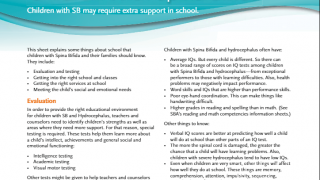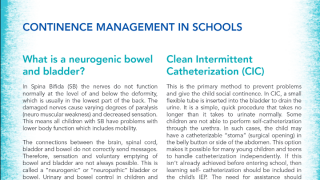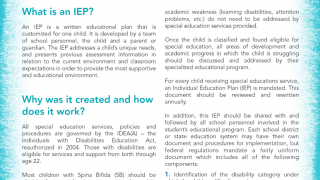Parents, teachers and health care professionals have observed that children with Spina Bifida may have problems with motor skills, attention, memory, and organization.
Research linking medical aspects of Spina Bifida and hydrocephalus to test scores concludes that children need to be evaluated psychologically and neuropsychologically evaluated to identify individual strengths and weaknesses. Once this testing takes place, the information can then be used for educational placement.
Recognizing and accessing learning problems
After testing results are learning profile assessment can be created and become part of the student’s Individual Education Program (IEP). The IEP is part of Public Law 94-142, which ensures appropriate education for all children who have learning disabilities. Learning weaknesses exist in children with Spina Bifida but are not always recognized by state or federal guidelines. The following eight areas describe some of these weaknesses and offer suggestions for helping children with Spina Bifida:
Perceptual-motor problems – Often, children with shunted hydrocephalus have poor eye-hand coordination and ineffective motor skills among children with Spina Bida interfere with the ability to move, use tools, read and write.
Comprehension – Children with Spina Bida sometimes have a hard time understanding concepts.
Attention – Children with Spina Bida often have trouble paying attention at school where they may miss assignments, complete work slowly or overlook social cues. If attention problems continue, it may be necessary to conduct evaluations for attention deficit and perhaps consider a therapeutic trial of medication.
Hyperactivity/Impulsivity – While physical impairment may mask the restlessness, children with Spina Bida often appear fidgety and impulsive. This behavior can get the children into trouble because they end up doing things quickly and carelessly. As with inattention, if these behaviors continue, a psychologist, pediatrician or neurologist should evaluate the children.
Memory – Even when children with Spina Bida understand what they see or hear, they often have difficulty remembering.
Organization – Children often have trouble keeping things organized and are likely to lose or misplace things.
Sequencing – Children and adolescents with Spina Bida often have trouble keeping ideas or doing activities in their proper order. Good stories that can be told in an orderly way may not easily be written down because children cannot organize ideas. Sequencing problems become obvious when doing math, telling time, and counting change.
Decision Making/Problem solving – People with Spina have trouble making decisions, which requires using what was learned in the past to solve a new problem now. If there comes a time when the child appears not to improve their problem solving or decision making, contact professionals.
This information does not constitute medical advice for any individual. As specific cases may vary from the general information presented here, SBA advises readers to consult a qualified medical or other professionals on an individual basis.
Tags



